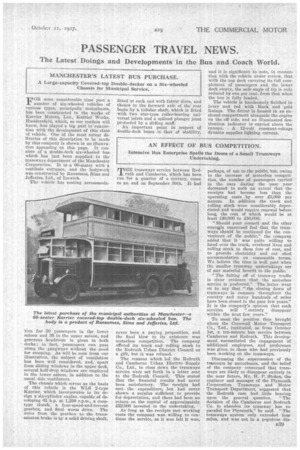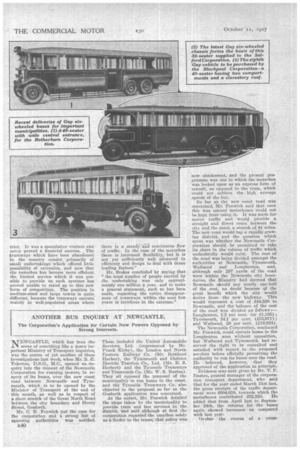AN EFFECT OF BUS COMPETITION.
Page 65

Page 66

If you've noticed an error in this article please click here to report it so we can fix it.
Intensive Bus Enterprise Spells the Doom of a Small Tramways Undertaking.
MEIE tramways service between Redruth and Camborne, which has been run for a quarter of a century,. came to an cud on September 30th. It had never been a paying proposition, and the final blow to its existence was motorbus competition. The company offered its track and rolling stock to the Redruth Urban District Council as a gift, but it was refused.
The reasons which led the Redruth and Camborne Urban Electric Supply Co., Ltd., to close down the tramways service were set forth in a letter sent to the Redruth Council. This stated that the financial results had never been satisfactory. The receipts had met. the expenditure, but had never shown a surplus sufficient to provide for depreciation, and there had been no return on the capital of approximately £2,000 invested in the undertaking.
As long as the receipts met .working costs the company was willing to continue the service, as it was felt it was, perhaps, of use to the public, but, owing to the increase of motorbus competition, the number of passengers carried in the cars during the past year decreased to such an extent that the receipts had become less than the operating costs by over £2,000 per annum. In addition the track and rolling stock were considerably depreciated and would require renewal before long, the cost of which would be at least 140,000 to f_50,000.
" Should your council and the other councils concerned feel that the tramways should be continued for the convenience of tbe public," the company added that it was quite willing to hand over the track, overhead lines and rolling stock to them free of cost, and to provide electricity and car shed accommodation on reasonable terms. We believe the time is well past when the smaller tramway undertakings are of any material benefit to the public.
"The falling off of tramway traffic is clear evidence • that the motorbus service is preferred." The letter went on to say that "the closing down of -tramways is common throughout the country and many hundreds of miles have been closed in the past few years." It is the company's opinion that such services will "entirely disappear .within the next few years."
To meet the position thus brought about the Cornwall Motor Transport Co., Ltd., instituted, as from October 1st, a ten-minute bus service between Camborne and Redruth. This development •necessitated the engagement of additional employees, and preference was given to those who had previously been working on the tramways.
Discussing the supercession of the tramcars by motorbuses, and the belief of the company concerned that tramways are likely to disappear entirely in the near future, Mr. H. P. Stokes, the engineer and manager of the Plymouth Corporation Tramways and Motor Transport Department, suggested that the Redruth case had little bearing upon the general question. "The decision of the Camborne and Redruth Co. to abandon it tramway has no parallel for Plymouth," he said. "The tramways system only extended four miles, and was not in a populous dis trict. It was a speculative venture ana never proved a financial success. The tramways which have been abandoned in the country consist primarily of small undertakings which offered little possibility of extension, and now that the motorbus has become more efficient the limited service which it was possible to provide on such systems has proved unable to stand up to this new form of competition. The position in medium-sized and large towns is quite different, because the tramways operate mainly in well-populated areas where
there is a steadi-aliii continuous flow of traffic. In the case of the motorbus there is increased flexibility, but it is not yet sufficiently well advanced in efficiency and design to deal with dense loading factors,"
Mr. Stokes concluded by saying that "the total number of people carried by the undertaking was only approximately one million a year, and to make a general statement, such as has been, made, regarding the entire disappearance of tramways within the next few years is invidious in the extreme."




















































































































